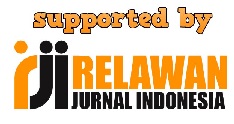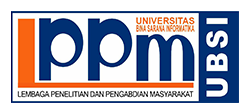ANALISA JUMLAH UANG BEREDAR DI INDONESIA TAHUN 2005-2014
Abstract
Money Supply are the monetary system (the Central Bank, Commercial Bank and Rural Bank / BPR) to the domestic private sector (excluding the central government and non-residents). Liabilities that are components of the The amount of money in circulation/ Money Supply consists of currency held by the public (outside of commercial banks and rural banks), demand deposits, quasi money owned by the domestic private sector, and securities other than shares issued by a monetary system that is owned by the domestic private sector with the remaining term of up to one year. (Bank Indonesia, 2015)Money Supply in circulation can be defined in a narrow sense (M1) and in the broad sense (M2). M1 includes currency held by the public and demand deposits (demand deposits denominated in Rupiah), while M2 includes M1, quasi money, and securities issued by a monetary system that is owned by the domestic private sector with a remaining term of up to one year. The method of analysis of the amount of money circulating in Indonesia, is the quantitative descriptive statistics. Empirical data periodically (time series) is studied descriptively by taking secondary data from the data in Bank Indonesia and Badan Pusat Statistik (BPS) with the period 2005 to 2014. The conclusion at period 2005 – 2014, M2 composed of quasi money and securities other than shares an important part in the amount of money circulating in Indonesia, compared to M1 money outside banks and demand deposits.
Keyword : money supply, currency, demand deposits, quasi money, securities
Full Text:
PDFReferences
Bank Indonesia, April 2016, DSta |Divisi Statistik Moneter dan Fiskal 1. http://www.bi.go.id/id/publikasi/kebijakan-moneter/tinjauan/Pages/Tinjauan-Kebijakan-Moneter-April-2016.aspx
Badan Pusat Statistik, 2016, Uang Beredar dan Faktor-Faktor yang Mempengaruhinya 2003– 2014, BPS. https://www.bps.go.id/linkTabelStatis/view/id/1331
Maya, M. Umar Putra, Peran Dan Kebijakan Moneter Terhadap Perekonomian Sumatera Utara, Jurnal Wira Ekonomi Mikroskil Volume 5, Nomor 01, Oktober 2015
Natsir, 2008, Peranan Jalur Suku Bunga Dalam Mekanisme TransmisiKebijakan Moneter Di Indonesia, Pascasarjana Unhalu Kendari
Rahardja Prathama, Manurung Mandala, 2008, Pengantar Ilmu Ekonomi (Mikroekonomi dan Makroekonomi) Edisi Ketiga, Lembaga Penerbit Fakultas Ekonomi Universitas Indonesia.
Sukirno Sadono, 2011, Makroekonomi Teori Pengantar Edisi tiga, Raja grafindo Persada.
Tambunan Tulus, 2011, Perekonomian Indonesia Kajian Teoritis dan Analisis Empiris,Ghalia Indonesia IKAPI.
http://www.bi.go.id/id/publikasi/perkembangan/Default.aspx (diakses tanggal 24 September 2016)
http://www.bps.go.id/linkTabelStatis/view/id/1294(diakses tanggal 24 September 2016)
DOI: https://doi.org/10.31294/moneter.v3i2.1196
Index by:
dipublikasikan oleh LPPM Universitas Bina Sarana Informatika dengan dukungan Relawan Jurnal Indonesia
Jl. Kramat Raya No.98, Kwitang, Kec. Senen, Kota Jakarta Pusat, DKI Jakarta 10450

This work is licensed under a Creative Commons Attribution-ShareAlike 4.0 International License






